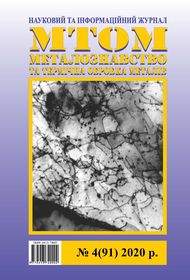Substantiation of the choice of thermokinetic parameters of cooling of steel k76f to increase the hardness over the section of the rail head
DOI:
https://doi.org/10.30838/J.PMHTM.2413.241120.30.688Keywords:
железнодорожные рельсы, химический состав, межпластиночное расстояние, кинетика распада, твердостьAbstract
Purpose.Determination of critical points and study of the kinetics of decomposition of supercooled austenite during continuous cooling of steel for rails with an increased content of manganese and microalloyed with vanadium, for substantiated development of thermal hardening modes.Methodology.The study of the kinetics of decomposition of austenite of heated samples was carried out in vacuum (5.0 • 10-4 mbar) with heating by high-frequency currents (2 MHz). The thermal cycle is determined by the program, which is based on the control of the sample temperature over time using a welded thermocouple (Pt−Pt/Rh 10 % alloy) with a diameter of 0,09 mm. Metallographic studies were carried out using an Axio Observer metallographic microscope and an РЄМ-106 scanning electron microscope. The inter-plate spacing in pearlite was determined by a linear method, the secant lines were located perpendicular to the plate packs. The Vickers hardness at a load of 10 kg was measured using a KB 30 automatic microhardness tester. The amount of structural components was assessed by micrograph using an image analyzer using the phase quantification method implemented in the Thixomet image analyzer. Results.The thermokinetic diagram analysis showed that the temperatures of the beginning and the end of the formation of ferrite, pearlite, and bainite decrease significantly with an increase in the cooling rate. With the implementation of rational heat treatment modes - cooling the surface of the steel rolling rails of no more than 5 °C/sec, the central volumes of the rail head at a rate of at least 2.5 °C/sec, it is possible to manufacture high-strength rails of the OT370ИK, ДT370ИK categories according to GOST R 51685-2013 from steel grade К76Ф with a content of 0.80 % C, 0.25 % Si, 0.97 % Mn, 0.055 % V. As a result of the analysis of the thermokinetic diagram of the investigated steel, it can be concluded that in the investigated steel grade K76F with 0.80 % C, 0.25 % Si, 0.97 % Mn, 0.055 % V it is impossible to achieve hardness above 400 HB without the formation of bainite.Scientific novelty.
A thermokinetic diagram of the decomposition of austenite of steel grade K76F with 0.80 % C, 0.25 % Si, 0.97 % Mn, 0.055 % V is constructed.Practical significance. It was found that on steel K76F with 0.80 % C, 0.25 % Si, 0.97 % Mn, 0.055 % V, it is impossible to achieve a hardness higher than 400HV without the formation of bainite, therefore, for the manufacture of high-strength rails of category R400НT according to EN 13674-1-2011 it cannot be used.
References
DSTU 4344:2004.Rejki zvichajnі dlja zalіznic' shirokoї kolії. Zagal'nі tehnіchnі umovi [Chinnij vіd 2005-10-01]. [DSTU 4344: 2004. Rails are common for wide gauge railways. General technical conditions [Valid from 2005-10-01]. Kyiv : Derzhspozhivstandart Ukrayiny, 2005, 31 p. (Nacіonal'nij standart Ukraїni). URL : (https:// ugmk.ua/dbs.8.files/gosts/d4344-20041_305.pdf). (in Ukrainian).
Uzlov I.G., Suhomlin G.D., Uzlov K.I. and Knysh A.V. Optimizacija parametrov otpuska cel'nokatanyh zheleznodorozhnyh koles povyshennoj prochnosti i iznosostojkosti na osnovanii jelektronnomikroskopicheskogo analiza [Optimization of the tempering parameters of solid-rolled railway wheels of increased strength and wear resistance on the basis of electron microscopic analysis]. Fundamental'nye i prikladnye problemy chernoj metallurgii : sb. nauchn. tr. IChM NANU [Fundamental and applied problems of ferrous metallurgy : sat. scientific. tr. HMI NANU]. Dnipropetrovsk : VІZІON, 2006, no. 13, pp. 143–148. URL : (http://dspace.nbuv.gov.ua/bitstream/handle/ 123456789/21681/17-Uzlov.pdf?sequence=1). (in Russian).
Uzlov I.G., Uzlov K.I., Knysh A.V. and Hulin A.N. Issledovanie mehanicheskih harakteristik lokomotivnyh bandazhej iz mikrolegirovannoj uglerodistoj stali povyshennoj tvjordosti i iznosostojkosti [Investigation of the mechanical characteristics of locomotive tires made of microalloyed carbon steel with increased hardness and wear resistance]. Stroitel'stvo, materialovedenie, mashinostroenie [Construction, materials science, mechanical engineering]. 2008, no. 45, part 1, pp. 164–169. URL : (file:///C:/Users/%D0%BE%D0%BA3/Downloads/smmit_2008_47_119.pdf).
(in Russian).
GOST R 51685–2013. Rel'sy zheleznodorozhnye. Obshhie tehnicheskie uslovija (EN 13674-1:2011, NEQ. [Data vvedenija 2014-07-01] [GOST R 51685–2013 Railway rails. General Specification (EN 13674-1: 2011, NEQ). [Date of introduction 2014-07-01]. Moscow : Standartinform, 2014, 96 p. (Nacional'nyj standart Rossijskoj Federacii). URL : (http://gostexpert.ru/data/files/51685-2013/68407.pdf). (in Russian).
Railway applications – Track – Rail – Part 1 : Vignole railway rails 46 kg/m and above : EN 13674-1:2011 (E). [With effect from 2011-08-01]. Brussels : European Committee For Standartization, 2011, 108 p. (CEN National Members). URL : (https://www.nlfnorm.cz/en/ehn/1599).
Downloads
Issue
Section
License
Authors that are published in this journal agree to follow the conditions:
Authors reserve the right to the authorship of his work and cede the right to the journal of first publication of this work on conditions of the license under the Creative Commons Attribution License, which allows others to distribute it freely with the obligatory reference to the author of the original work and the first publication of the work in this journal.

